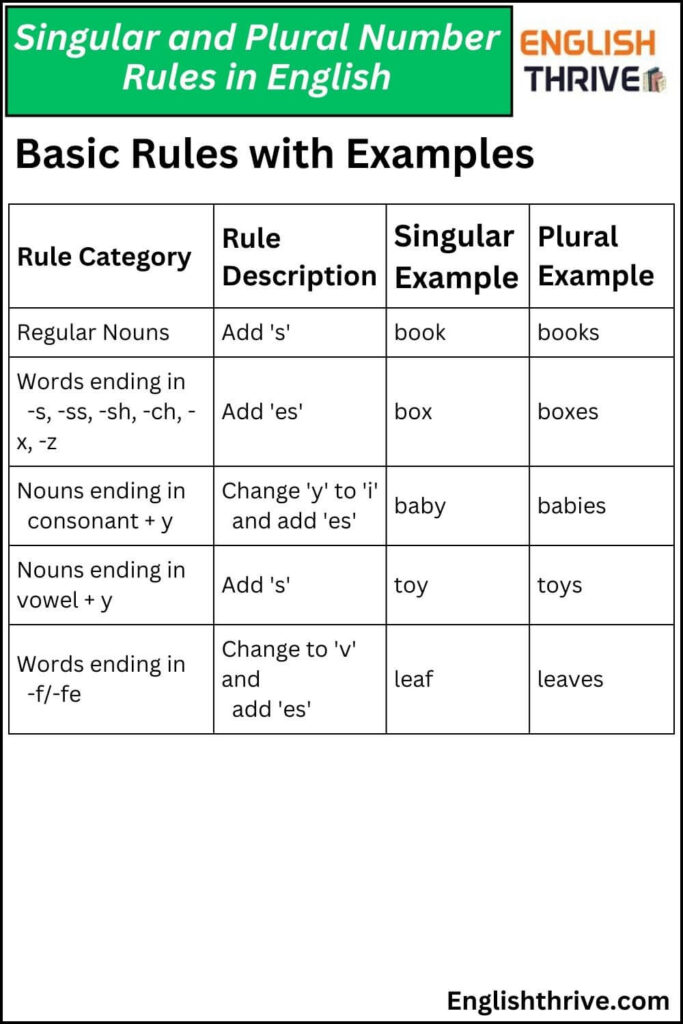Have you ever noticed how “they walk” sounds right, but “they walks” feels off? Welcome to the fascinating world of third person plural numbers in English grammar! This fundamental aspect of language helps us talk about groups of people, things, or ideas in a way that flows naturally. As someone who’s taught English for years, I can tell you that mastering this concept opens up a whole new level of confidence in both speaking and writing.
Contents
ToggleThird Person Plural Number Meaning
The third person plural refers to groups or multiple entities (they, these, those) and usually takes the base form of the verb without any additional endings. Think of it as the simpler cousin of the third person singular – no extra ‘s’ or ‘es’ needed!
Basic Usage Patterns
| Subject Type | Base Form | Third Person Plural | Example Sentences |
|---|---|---|---|
| Regular Verbs | walk | walk | They walk together |
| Irregular Verbs | have | have | The dogs have food |
| Be/Do/Go | are/do/go | are/do/go | The children are playing |
| Action Verbs | run | run | The athletes run fast |
| State Verbs | know | know | The teachers know the answer |
Common Examples in Context
| Subject | Verb Form | Example Sentence | Usage Context |
|---|---|---|---|
| They | study | They study medicine | Academic |
| The cats | sleep | The cats sleep all day | Animals |
| These books | belong | These books belong here | Possessions |
| My friends | travel | My friends travel often | Activities |
| The clouds | move | The clouds move slowly | Nature |
Practice Exercises
- Fill in the blanks with the correct verb form:
- The students _____ (write) essays
- Those cars _____ (need) repairs
- My neighbors _____ (work) late
- Error Correction:
- ❌ They walks to school
- ✅ They walk to school
Third Person Plural Number Meaning , Examples, and Exercises
Singular and Plural Number Rules in English
Here’s a comprehensive guide to English singular and plural number rules, organized in an easy-to-reference format.
Basic Rules with Examples
| Rule Category | Rule Description | Singular Example | Plural Example |
|---|---|---|---|
| Regular Nouns | Add ‘s’ | book | books |
| Words ending in -s, -ss, -sh, -ch, -x, -z | Add ‘es’ | box | boxes |
| Nouns ending in consonant + y | Change ‘y’ to ‘i’ and add ‘es’ | baby | babies |
| Nouns ending in vowel + y | Add ‘s’ | toy | toys |
| Words ending in -f/-fe | Change to ‘v’ and add ‘es’ | leaf | leaves |
Special Cases and Exceptions
| Rule Type | Singular Form | Plural Form | Additional Examples |
|---|---|---|---|
| Irregular Plurals | mouse | mice | foot → feet, tooth → teeth |
| Latin/Greek Origins | criterion | criteria | phenomenon → phenomena |
| No Change | sheep | sheep | deer, fish, species |
| Always Plural | – | scissors | trousers, pants, glasses |
| Compound Words | mother-in-law | mothers-in-law | sister-in-law → sisters-in-law |
O-Ending Words
| Rule | Singular | Plural | Notes |
|---|---|---|---|
| Add ‘s’ | piano | pianos | Most modern/foreign words |
| Add ‘es’ | hero | heroes | Traditional English words |
| Either ‘s’ or ‘es’ | volcano | volcanos/volcanoes | Both forms accepted |
Foreign Word Plurals
| Language Origin | Singular | Plural | Additional Example |
|---|---|---|---|
| Latin | nucleus | nuclei | fungus → fungi |
| Greek | analysis | analyses | crisis → crises |
| Italian | spaghetto | spaghetti | graffito → graffiti |
| Hebrew | kibbutz | kibbutzim | cherub → cherubim |
Numbers, Letters, and Symbols
| Category | Singular | Plural | Example in Sentence |
|---|---|---|---|
| Numbers | 5 | 5’s | I got two 5’s on my test |
| Letters | A | A’s | She got straight A’s |
| Abbreviations | PhD | PhDs | Many PhDs attended |
| Decades | 1990 | 1990s | The 1990s were great |
Special Collections
| Collection Type | Singular | Plural | Usage Note |
|---|---|---|---|
| Groups | team | teams | Can use singular or plural verb |
| Pair Items | sock | socks | Usually used in pairs |
| Mass Nouns | water | – | No plural form |
| Abstract Concepts | happiness | – | Usually no plural |
Remember:
- When in doubt about foreign words, the anglicized plural (adding ‘s’) is usually acceptable
- Some words have multiple accepted plural forms
- Context can sometimes determine whether to use singular or plural
- Regional variations might affect which plural form is preferred
- Professional/academic writing might require strict adherence to traditional plural forms
Practice Exercise: Try pluralizing these words:
- child (children)
- ox (oxen)
- datum (data)
- medium (media)
- cactus (cacti/cactuses)
- index (indices/indexes)
- formula (formulae/formulas)
- criterion (criteria)
- phenomenon (phenomena)
- appendix (appendices/appendixes)
Practice Exercise Answers with Explanations
1. Child → Children
Explanation: This is an irregular plural form using the ancient Germanic suffix ‘-en’. This same pattern appears in a few other English words like ‘oxen’ and ‘brethren’.
2. Ox → Oxen
Explanation: Like ‘children’, this word maintains the Old English plural suffix ‘-en’. It’s one of the few words in modern English that still uses this plural formation.
3. Datum → Data
Explanation: This word comes from Latin. While ‘data’ is technically the plural form, it’s now commonly used as both singular and plural in everyday English, especially in computing and statistics.
4. Medium → Media
Explanation: Another Latin-derived word. While ‘media’ is the correct plural, it has also evolved to become a collective noun, especially when referring to mass communications.
5. Cactus → Cacti/Cactuses
Explanation: Both forms are correct. ‘Cacti’ follows the Latin plural pattern, while ‘cactuses’ follows the standard English plural formation. Both are widely accepted.
6. Index → Indices/Indexes
Explanation: Both plurals are correct but often used in different contexts. ‘Indices’ is more common in mathematical or technical contexts, while ‘indexes’ is more common in general use.
7. Formula → Formulae/Formulas
Explanation: ‘Formulae’ is the traditional Latin plural, while ‘formulas’ is the anglicized version. Both are correct, with ‘formulas’ being more common in everyday use.
8. Criterion → Criteria
Explanation: This word follows the Greek plural pattern. Note that ‘criteria’ is plural – a common mistake is using it as singular.
9. Phenomenon → Phenomena
Explanation: Another Greek-origin word. ‘Phenomena’ is the plural form, though sometimes mistakenly used as singular in casual speech.
10. Appendix → Appendices/Appendixes
Explanation: Both forms are acceptable. ‘Appendices’ is more formal and follows the Latin pattern, while ‘appendixes’ follows regular English pluralization.
Pro Tip: When using these words in professional or academic writing, it’s best to use the traditional plural forms (like ‘criteria’ and ‘phenomena’). In everyday communication, the anglicized versions are usually acceptable.
FAQs on Third Person Plural Number
Why don’t we add ‘s’ in third person plural?
The absence of ‘s’ in third person plural forms represents a fascinating aspect of English language evolution. This simplification occurred naturally over centuries as English moved away from the complex inflectional systems of its Germanic roots. The lack of additional markers in plural forms makes the language more efficient for communication while maintaining clarity through context and subject-verb agreement. This pattern also helps reduce cognitive load for both native speakers and language learners, allowing for more fluid expression of ideas involving multiple subjects or groups.
How can I remember when to use plural forms?
Mastering third person plural forms involves understanding the underlying patterns and relationships between subjects and verbs. The key is to identify the subject clearly – if it represents more than one person, animal, or thing, you’ll use the base form of the verb. Think of it like a dance – when multiple dancers are involved, they all follow the same basic steps without any extra flourishes. This systematic approach helps create a natural rhythm in your speech and writing, making it easier to maintain proper grammar even in complex sentences.
What about irregular plural forms?
English irregular plural forms present a unique challenge because they evolved from various historical influences and language changes. While most verbs maintain their base form with plural subjects, some nouns have special plural forms that must be learned individually. Understanding these irregularities requires recognizing patterns within smaller groups of words that share similar transformations. For instance, words like “children,” “oxen,” and “brethren” follow an ancient plural-forming pattern that has survived in modern English.

